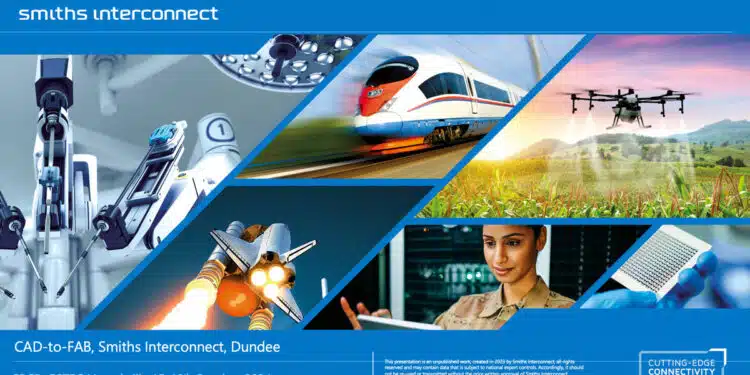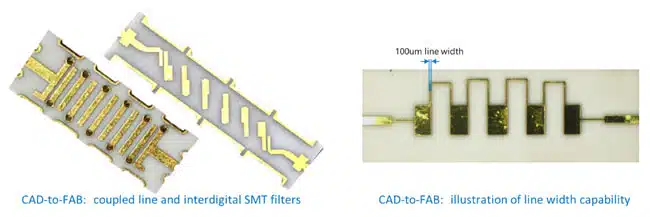This paper CAD-to-FAB: an introduction to the recent and ongoing investment in the capability to produce, at scale a variety of planar RF passive structures was presented by Alan Mc Neill, Smith Interconnect, UK during the 5th Space Passive Component Days (SPCD), an International Symposium held from October 15th to 18th, 2024, at ESA/ESTEC in Noordwijk, the Netherlands. Published under permission from ESA SPCD organizers.
Introduction
The development of Radio Frequency (RF) passive components is undergoing a transformative shift driven by the need for more integrated, cost-effective, and scalable manufacturing processes.
Traditional RF component production methods, typically reliant on automated workflows, are not ideal for environments demanding a high mix of products with low volumes. This has led to prolonged development cycles, high prototyping costs, and extended production lead times.
Addressing these challenges, Smiths Interconnect has introduced an innovative manufacturing approach known as CAD-to-FAB. This process leverages both additive (like 3D printing) and subtractive (such as computer-controlled machining) techniques to achieve flexible, scalable, and cost-efficient production of planar RF passive structures.
Key Points:
- Introduction of CAD-to-FAB: Combines additive and subtractive manufacturing techniques for RF passive components.
- Investment Motivation: Focuses on SWaP-C (Size, Weight, Power, Cost) optimization to integrate passive functions into compact assemblies.
- Prototype & Scaling: Prototype system operational; full-scale system scheduled for commissioning in early 2025 at Dundee, Scotland.
- Product Applications: Development of SMT components from C to Ka-bands, including isolators, circulators, couplers, and RF filters.
- Roadmap & Future Plans: Expansion to Ka-band and potential applications in space-qualified environments.
Extended Summary:
Smiths Interconnect has pioneered a new digital manufacturing paradigm through its CAD-to-FAB process, specifically designed to overcome the limitations of traditional RF passive component production. The CAD-to-FAB approach integrates direct, computer-controlled manufacturing techniques, including both additive and subtractive methods. Unlike traditional production methods, which are cost-prohibitive at low volumes, CAD-to-FAB offers a flat cost-to-volume curve, making it economically viable for both low and high production runs.
The motivation behind this investment is driven by the SWaP-C criteria—optimizing Size, Weight, Power, and Cost—critical for modern RF applications. The CAD-to-FAB process supports the development of complex multi-function assemblies by integrating passive functions such as ferrite isolators, circulators, RF filters, and couplers into compact, high-performance modules. The initial prototypes, including a C-band high-power isolator, have shown remarkable consistency and performance, highlighting the potential of this technology.
The CAD-to-FAB system presently focuses on Surface-Mount Technology (SMT) components ranging from C to Ka-bands. Its capabilities extend to producing microstrip and SMT non-reciprocal devices, RF filters, couplers, and power combiners. The process ensures high precision, with computer-controlled patterning achieving accuracies within +/- 5 micrometers. The automated assembly integrates advanced machine vision for quality assurance, reducing the need for exhaustive RF testing.
Looking forward, Smiths Interconnect’s roadmap includes the development of X-band circulators and K-band isolators, with plans to expand into Ka-band applications by early 2025. Although traditional space qualification processes are not yet planned, the materials used are already space-qualified, and efforts will focus on adapting SMT component mounting for space applications.
Conclusion:
The CAD-to-FAB initiative represents a significant leap in RF passive component manufacturing, offering flexibility, scalability, and cost efficiency. By investing in digital manufacturing technologies, Smiths Interconnect aims to reduce lead times, lower production costs, and enhance product customization. Supported by substantial funding from the UK Space Agency and Smiths Group, the CAD-to-FAB facility in Dundee is set to become a cornerstone in the production of advanced RF components, positioning Smiths Interconnect at the forefront of RF technology innovation.
Read the full paper:































